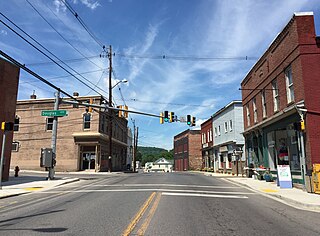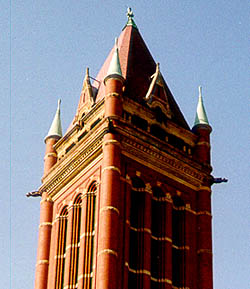
Barton is a town in Allegany County, Maryland, United States, located along the Georges Creek Valley. It is part of the Cumberland, MD-WV Metropolitan Statistical Area. The population was 457 at the 2010 census.
Maryland Route 36 is a 29.43-mile (47.36 km) state highway located in Allegany County, Maryland, United States. MD 36's southern terminus is at the West Virginia Route 46 (WV 46) bridge in Westernport and its northern terminus at U.S. Route 40 Alternate near Cumberland. Between Westernport and Frostburg, it is known as Georges Creek Road, and from Frostburg to Cumberland it is known as Mount Savage Road. Like the majority of Maryland state highways, MD 36 is maintained by the Maryland State Highway Administration (MDSHA).

Mount Savage is an unincorporated community and census-designated place (CDP) in Allegany County, Maryland, United States. As of the 2010 census it had a population of 873.
The Georges Creek Railroad was a railroad operated by the Georges Creek Coal and Iron Company in Western Maryland. The railroad operated from 1853 to 1863, when it was acquired by the Cumberland and Pennsylvania Railroad (C&P).
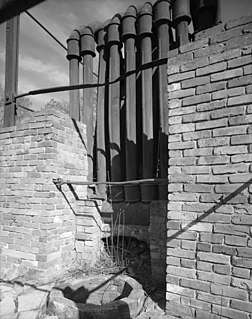
The Nassawango Iron Furnace was built in 1830 by the Maryland Iron Company to produce iron from bog ore deposits in its vicinity. It is notable for its innovative use of a "hot blast" technique for smelting the iron, which had only been developed in England around 1828, and which may have been added to the Nassawango Furnace in 1837. Due to the variable nature of the bog ore deposits, the furnace stopped operations in 1849.

The Shaw Mansion is an Italianate style house in the George's Creek Valley of Allegany County, Maryland, built in 1872. The house is significant as an unusually large and well-preserved example of the style for its area, with stone trim, detailed brick bonding, cast-iron mantels and much of the original interior woodwork.

16 Altamont Terrace is a historic home in Cumberland, Allegany County, Maryland, United States. Built circa 1851, it is an example of Greek Revival architecture, with an Ionic portico above a stone foundation and cast iron balconies. The house served as the Allegany County hospital from 1889 to 1890. The building was converted into apartments in about 1905.

Big Bottom Farm is a farm in Allegany County, Maryland, USA on the National Register of Historic Places. The Greek Revival house was built circa 1845, possibly by John Jacob Smouse, and exhibits a level of historically accurate detailing unusual for the area. The property includes a late 19th-century barn and several frame outbuildings.
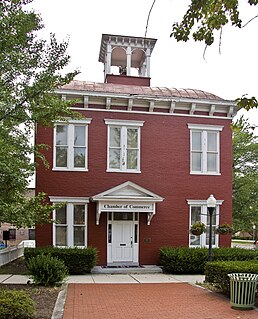
Bell Tower Building, or the Allegany County League for Crippled Children building, is a historic building in Cumberland, Allegany County, Maryland. It was built in 1887 and is a two-story brick structure topped by a small wooden tower with an open belfry. This was the first separate building to be used as police headquarters and jail in Cumberland.
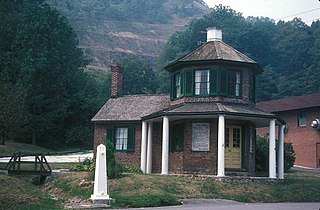
La Vale Tollgate House is a historic toll house in La Vale, Allegany County, Maryland, United States. It is a two-story brick structure built in 1835-1836, with seven sides—a basic polygon plan. A one-story Tuscan-columned porch extends around the five outer sides of the polygonal portion. On top is a non-functional reconstructed cupola. The building served as a toll house on the Cumberland or National Road and was the first such structure to be erected.

The Lonaconing Historic District is a national historic district in Lonaconing, Allegany County, Maryland. It comprises 278 buildings and structures consisting of a variety of 19th and early-20th century commercial, industrial, and residential buildings. These structures identify with the development of Lonaconing as a center of the iron, coal, and silk industries in the George's Creek Valley of Western Maryland. It includes a group of 40 late-19th and early-20th century brick or frame commercial structures, including a hotel, bank, three dry goods stores, and numerous other shops and warehouses, mostly constructed after a fire which devastated downtown in 1881.
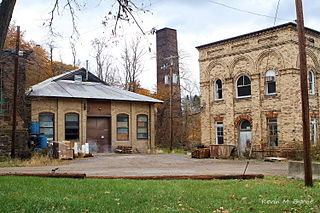
The Mount Savage Historic District is a national historic district in Mount Savage, Allegany County, Maryland. It comprises 189 19th and 20th century buildings, structures, and sites within this industrial community northwest of Cumberland. The structures reflect the community's development as a center of the iron, coal, brick, and railroad industries from the 1830s to the early 20th century. Included are a set of vertical-board duplexes on Old Row built about 1840, and possibly the earliest examples of workers' housing remaining in the region.

The Inns on the National Road is a national historic district near Cumberland, Allegany County, Maryland. It originally consisted of 11 Maryland inns on the National Road and located in Allegany and Garrett counties. Those that remain stand as the physical remains of the almost-legendary hospitality offered on this well-traveled route to the west.

Antietam Iron Furnace Site and Antietam Village is a national historic district at Antietam, Washington County, Maryland, United States. The district consists of the remains of a mid-18th to late-19th century iron furnace site, and the nearby related village. Remnants of the ironworks include a dam and race, a possible wheel pit or building foundation, the possible location of a furnace stack, a four-arch stone bridge built by John Weaver in 1832. Also at the site are the dozen or so brick, stone, and wood houses comprising Antietam Village. Typical of the houses is the Mentzer house, a four-bay, two-story, stone structure constructed of roughly coursed fieldstone and painted white.

The Dunlap coke ovens are the remnants of a coke production facility near Dunlap, in the U.S. state of Tennessee. Built in the early 1900s, the facility consists of five batteries of 268 beehive ovens, which operated under various companies until the early 1920s. The ovens are now listed on the National Register of Historic Places, and are maintained by the Sequatchie Valley Historical Society as part of Dunlap Coke Ovens Park.

The Brierfield Furnace, also known as the Bibb Naval Furnace and Brierfield Ironworks, is a historic district in Brierfield, Alabama. The district covers 486 acres (197 ha) and includes one building and nine sites. It was listed on the National Register of Historic Places on November 20, 1974. The district is encompassed by Brierfield Ironworks Historical State Park.
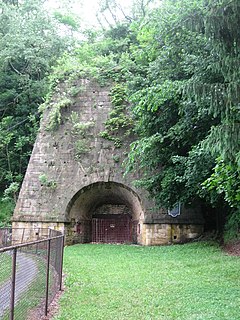
Farrandsville Iron Furnace, also known as Lycoming Coal Co., is a historic iron furnace located at Colebrook Township in Clinton County, Pennsylvania about 6 miles northwest of Lock Haven. It was built between 1836 and 1837, and measures 43 feet square by 54 feet high. It is a rare example of an early attempt to adopt coke as a blast furnace fuel.

The Cherry Valley Coke Ovens consisted of 200 coke ovens built by the Leetonia Iron and Coal Company around 1866, near Leetonia, Ohio, United States. The function of the "beehive" coke ovens was to purify coal and turn it into coke. The coke was burned in furnaces that produced iron and steel.

Farrandsville is an unincorporated community in Colebrook Township in Clinton County in the U.S. state of Pennsylvania. It is on the north side of the West Branch Susquehanna River about 4 miles (6 km) upstream from Lock Haven at the north end of Farrandsville Road. Whisky Run and Lick Run flow through Farrandsville.

